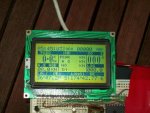TheDotFactory. That is really clever. Makes it much easier to generate fonts.
Your English is perfect. No problems there.
So, you run the font program, and does that generate a file? And how do you get that data into the eeprom? Is that in the main program or is it another program?
I know you said it was easy, but it looks very complicated, but your code makes it easy.
With 5x5 characters, I think your display is by far the cheapest display I've seen in terms of $ per character. Do you have one line between each character? (so 5x5 actually takes 6x6)
I'm starting to think crazy thoughts now. Text and graphics on a picaxe. Small windows that you can open and close. Little buttons, text boxes. A GUI for a picaxe...


